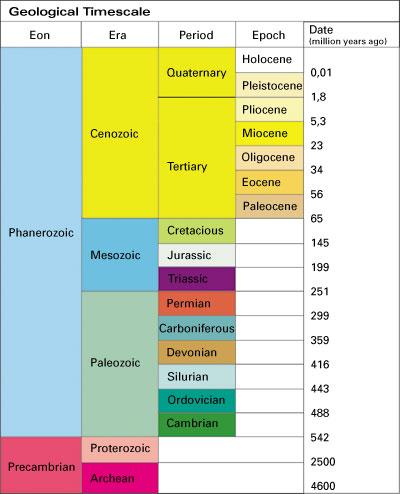5.3.1 Precambrian climate
To study the Earth's climate during the first billion years of its history, we have to rely on indirect estimates. For instance, the presence of glacial sediments during a particular period indicates glaciation, at least on a regional scale. Specific conditions are required for the formation of various rock types, providing additional indications of past climate changes. However, the uncertainties are very large and the climate reconstructions, which are at best qualitative, are regularly modified as new information becomes available.

|
The evidence for the climate of the early Earth is particularly scarce. When Earth was formed about 4.6 billion years ago, the solar irradiance was about 30% lower than at present. If the conditions (albedo, composition of the atmosphere, distance between the Earth and the Sun, etc) then had been the same as they are now, a simple calculation using the models described in section 2.1.2 leads to an averaged surface temperature 30oC below than today's. During the first 700-800 million years, the continual bombardment by small planetesimals and meteorites would certainly have warmed the climate. Nevertheless, in such conditions, the Earth would have been frozen during a large part of its history. This contrasts with geological evidence for a liquid ocean at least 4 billion years ago. The apparent discrepancy is called the "faint early Sun paradox".
The main cause of this paradox is thought to be that there was a much stronger greenhouse effect during the early lifetime of the Earth. The atmosphere was very different from today, with a much higher CO2 concentration (probably reaching more than 10%, i.e. more than 100 times the present-day value) and nearly no oxygen. In the absence of oxygen, the methane was not quickly oxidised, as in the present atmosphere (see Eq. 2.37), and its concentration was much higher than today. It has been hypothesised that it was the dominant greenhouse gas at this time.
With time, the atmospheric composition has been modified, in particular because of the oxygen liberated by photosynthesis. This oxygen was first used to oxidise the mineral exposed to the atmosphere. Subsequently, it accumulated in the atmosphere, leading to a large increase in the atmospheric oxygen concentration 2.2. to 2.4 billion years ago as well as to the formation of an ozone layer in the stratosphere. Because of these higher oxygen concentrations, the oxidation of methane became more efficient and its concentration decreased markedly. As the rise in the amount of oxygen was concurrent with a glaciation, it has been suggested that the reduced methane concentration was responsible for the cooling. However, the evidence to confirm this hypothesis is still lacking.
Several large climate fluctuations have occurred during the Precambrian eon (Fig. 5.10). One of the best documented is a glaciation that takes place around 600 to 750 million years ago. It was apparently so severe that the whole Earth might have been totally covered by ice during some of this glacial period. At that time, all the continents were grouped close to the South Pole (Fig. 5.11). This maybe have initiated a cooling of the continents, probably during a time when the orbital configuration favoured the growth of ice sheets (see section 5.4). After this initial cooling, the ice-albedo feedback (see section 4.2.3) was strong enough to generate an additional temperature decrease leading to a progression of ice towards the Equator and eventually covering the whole Earth.

|
This "snowball hypothesis" is still debated because it has been argued that such a configuration would be a stable equilibrium state of the climate system, and thus the Earth would have remained permanently frozen. However, it has also been postulated that during the snowball phase, volcanoes would have continued to outgas CO2 into the atmosphere. As the Earth was covered by ice, no weathering of rocks would have compensated the CO2 input and the atmospheric CO2 concentration would have increased greatly. Furthermore, ash and dust may have modified the albedo of ice in this very dry environment with very little precipitation. This may have eventually led to a melting of the ice in the tropics and a deglaciation of the Earth thanks to the ice-albedo feedback. Finally, as the CO2 concentration was still high after this deglaciation, the adjustment of the carbon cycle to such perturbations being very slow, the snowball Earth may have been followed by very warm conditions.




